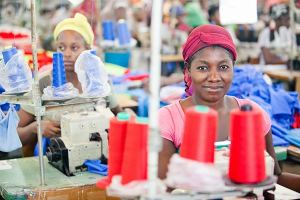
When you’re up against a challenge as big as improving conditions for workers in Haiti’s garment sector, it’s easy to lose sight of the progress being made and focus on the problems. Risks to health and safety are still among the biggest. More than three in four factories in Haiti don’t meet the requirements for emergency preparedness.
I work as an Enterprise Advisor for Better Work Haiti. It’s my job to assess factories and help workers and employers to solve problems and improve working conditions. When we first started operations in 2009, the words “Occupational Safety and Health” weren’t in the vocabulary here. When talking to workers and managers about the basics of how to keep safe, we were often starting from scratch.
 The ILO celebrates the World Day for Safety and Health at Work on the 28 April to promote the prevention of occupational accidents and diseases globally. Find out more
The ILO celebrates the World Day for Safety and Health at Work on the 28 April to promote the prevention of occupational accidents and diseases globally. Find out moreYet, workers know about their own working conditions better than anyone else. My team recognized from the earliest stages that if we wanted to make a lasting impact, we had to get them involved. So we started by setting up worker-management health and safety committees. Their goal was to assess conditions at their factories, tackle health and safety issues and train workers on how to stay safe.
Just three years ago, not a single factory in Haiti had a health and safety committee. Today, they’ve been set up at 23 different factories, which together produce all of Haiti’s garment exports to the United States.
One of the biggest challenges we face is creating trust between the management and workers. That means breaking down barriers and establishing open lines of communication. On average, it takes a full year to get a health and safety committee set up. Commitment from the management to allow input from workers is a vital part of the process.
But after three years, the hard work of managements, government, unions and buyers is starting to pay off. More and more, health and safety committees are taking charge of precautions that protect workers from injury every day. Ensuring they have needle guards to protect their hands and fingers and know not to stack boxes in front of fire extinguishers are just a few examples. In fact, when a phone cable sparked a small factory fire recently, the workers responded immediately, using a fire extinguisher to put it out before anyone was injured.

Better Work is a partnership between ILO and the International Finance Corporation (IFC). Find out more about Better Work Haiti
Of course, making factories better places to work can come at a price. For example, energy costs are high in Haiti and keeping a factory cool during the summer is expensive. And there’s still much more work to be done. Factories need better systems for recording accidents and we need to further raise awareness about the importance of wearing protective gear. Heat and noise levels will have to be addressed.
But on the whole, we’re on the right track. We want to get to the stage where workers are so informed and empowered to act on safety issues that they can tackle problems as they arise. We want them to tell mechanics, “don’t take off that needle guard” or tell their supervisor, “look, that wire isn’t safe.”
We’re not there yet, but that’s where we’re headed.
